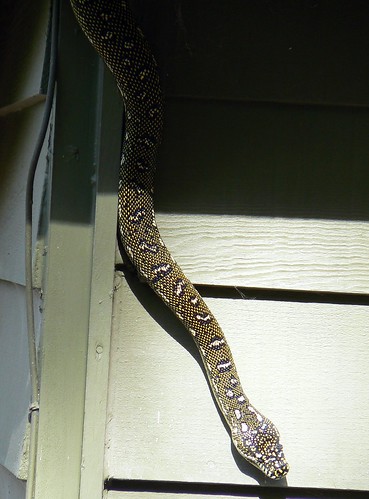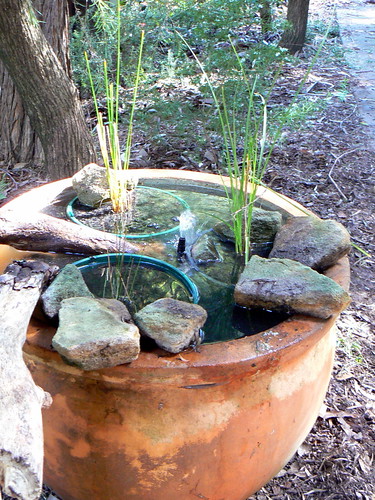Hi everyone!
Busy times. I've been working hard on the garden. The beds near the front verandah were full of nasty exotic things, and they're gone now. In their place I've put in lots of new things, a goodly array of small trees, shrubs, monocots and ground covers.

In this bed is an established
Ceratopetalum gummiferum, a New South Wales Christmas Bush, which has magnificent red sepals in summer. Against the lattice, I've planted
Pandorea pandorana (Wonga Wonga vine). In front of those is an Acacia terminalis and a Grevillea olivacea x preissii which I grew at TAFE as one of my propagation assignments, and there are a couple of Goodenia ovata (with yellow flowers), to match the Acacia. I've planted a few Lomandra longifolia and Lomandra fluviatilis here and there, and in the foreground is a Zieria prostrata. Throughout, I've sown Dichondra repens seed as a ground cover.

This bed is very floral. I've planted as centrepieces, an
Acacia fimbriata, a hybrid Leptospermum and a Corymbia ficifllia x ptychocarpa--the latter two have deep pink flowers. As smaller shrubs, I've planted Lomatia silaifolia, Crowea saligna and Melaleuca thymifolia. For ground covers, I've put in Brachyscome formosa, Brachyscome angustifolia, Brachyscome multifida, Wahlenbergia stricta, Dampiera diversifolia, Chrysocephalum apiculatum which will hopefully create a carpet of pink, blue and yellow. To create textural contrast, I added a few Patersonia sericea.
Once these become established, spring will bring a mass of colour! In my not too modest opinion.
Speaking of a lack of modesty, last week I was presented with the Award for Outstanding Graduate for my TAFE horticulture course last year! I was chuffed, especially when I discovered it entailed a book voucher from the wonderful bookshop Floreligium. Today the books I ordered arrived: the latest edition of
"Frogs and Reptiles of the Sydney Region" by Ken Griffiths, and
"Mycelium Running: how mushrooms can help save the world". Gorgeous.
My science degree begins in July. The course I'm starting with is
Foundations for Resource and Environmental Management. I'm lowering myself back into tertiary education gently, so I'm starting with one course only.
The backyard vegie patch is coming on apace. Photos soon. I've planted peas, silver beet, rocket and cabbage, as well as nasturtiums and marigolds as companion plants, and I've mulched and set up an irrigation system and a fence to keep out the wallabies. They're looking good so far: no pests.
But alas, the wallabies got to my lemon tree. Now it has no leaves and no fruit. Still, they were here first so I can't complain. I've planted a Feijoa tree, but I'm not letting any damned marsupial near it. It's thoroughly protected by a plastic guard.
And I've started work on the pond. This really excites me! My plan is to put a waterfallish thing above a crack between two sandstone platforms. The water will flow down to pond number 1, and from there into a larger pond.
Update:
I've started a new section on my Growing Passion website, devoted to the construction of the pond. Please take a look. I'll update it frequently, as the work gets done.
The first stage is removing huge tracts of the bloody agapanthus some nong planted. The more established plants have extensive root systems, and the only way to remove them is with brute force and lots of sweat. Still, it's satisfying work. And it's nice to have help. Here's Martien, hard at it. What a fine lad.

Agapanthus massacres are quite cathartic. During one I found a lone
Epacris longiflora. It is looking rather sad, but now it's lost its competitors for space, light, nutrients and water, maybe it will be happier.
I also must tell you about the website of my friends, Stewart and Susie, on their swimming-pool-turned-into-pond:
Pool to Pond. Stunning, huh? They're an inspiration. If you've a pool you don't want any more, forget about the expense of filling it in. This is the environmentally wonderful solution. Wouldn't you just love these plants and animals in your backyard?
Meanwhile, I'm continuing my volunteer work at the Herbarium's Plant Pathology Lab. Loving it to pieces. I'm even getting to do DNA extractions alone and without the aid of a net!
The closing date for applications for the Herbarium
AVH position has ended. I've finished my application and mailed it off. It felt like a smallish novella. Please keep your fingers crossed for me.
Check out this gorgeous diamond python resident in the neighbours' roof! It vanished, apparently, during the bushfires, and rats invaded the roof. Now it's back and the rats are gone. I know which I'd prefer.

The other day, I saw a male
Superb Lyrebird (
Menura novaehollandiae) in the garden, right next to the house. Wish I could have got a pic, but it ran away too quickly, alas. Damn but I love the wildlife here....
Oh, and we've got a new puppy--a border collie--
Trillian, as a companion for Miepje. Isn't she beautiful? But naughty. Very, very naughty. Like Miepje, we got her from the RSPCA. Unlike Miepje, she's not in the least traumatised by her early experiences. She's ridiculously confident about the world. Smart as a button.









